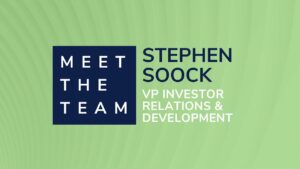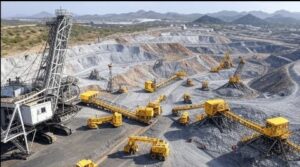Executives
Jeff Wilhoit – Vice President, Investor Relations
Chuck Jeannes – President and Chief Executive Officer
Lindsay Hall – Chief Financial Officer
George Burns – Chief Operating Officer
Russell Ball – Executive Vice President, Capital Management
Analysts
Andrew Quail – Goldman Sachs
Anita Soni – Credit Suisse
John Tumazos – John Tumazos Very Independent Research
Kenneth Hackel – CT Capital
Goldcorp Inc. (GG) Q4 2013 Earnings Conference Call February 13, 2014 1:00 PM ET
Operator
Good day, ladies and gentlemen. Welcome to the Goldcorp Inc. 2013 Fourth Quarter and Year End Conference Call for Thursday, February 14, 2014. Please be advised that this conference call is being recorded.
I would now like to turn the meeting over to Mr. Jeff Wilhoit, Vice President, Investor Relations of Goldcorp. Please go ahead, Mr. Wilhoit.
Jeff Wilhoit
Thank you and welcome everyone to the Goldcorp fourth quarter and year-end earnings conference call. Among the senior management in the room with me today are Chuck Jeannes, President and Chief Executive Officer; Lindsay Hall, Chief Financial Officer; George Burns, Chief Operating Officer; and Russell Ball, Executive Vice President, Capital Management.
For those of you participating on the webcast, we have included a number of slides to support this mornings discussion. These slides are available on our website at www.goldcorp.com.
As a reminder, we will be discussing forward-looking information that involves unique risks concerning the business, operations, and financial performance and condition of Goldcorp. Forward-looking statements include, but are not limited to, statements with respect to future metal prices, the estimation of mineral reserves and resources, the timing and amount of estimated future production, cost of production, capital expenditures and cost and timing of the development of new deposits.
Forward-looking statements are subject to known and unknown risks, uncertainties and other factors that may cause the actual results to be materially different from those expressed or implied by such forward-looking statements. Accordingly, you should not place undue reliance on forward-looking statements.
With that, I will now turn the call over to Chuck Jeannes, President and CEO.
Chuck Jeannes
Thanks Jeff and thanks everyone for joining us today. Those of you who know us well at Goldcorp are aware that one of our highest priorities is on execution delivering on our goals and objectives that we set each year. So Im pleased to report that we achieved our objectives again in the fourth quarter and for the full 2013 year. We beat up cost guidance on an all-in sustaining and co-product basis and we delivered successfully on gold production guidance due in part to a very strong quarter as we reported in January.
Fourth quarter gold production was a record 769,000 ounces at all-in sustaining cost of $810 per ounce driven by great operating results at Peñasquito and Red Lake as well as higher throughput at Pueblo Viejo. Our operation for excellence continues improvement initiative (indiscernible) also contributed significantly to bringing down our overall cost as we gained efficiency and productivity improvements across all of our sites.
These cost savings help to offset lower than planned byproduct metal prices. With each new (indiscernible) success story we expect further positive contributions to our cost profile in 2014 and beyond. This cost discipline combined with record production drove our adjusted quarterly revenues to $1.2 billion leading to adjusted earnings of 74 million and strong adjusted operating cash flow of $439 million. The reported net loss of $1.1 billion was due primarily to non-cash charges booked to account for new taxes in Mexico and Guatemala as well as the charge at the Alumbrera joint venture due to increased closure costs as it nears the end of it’s mine life and lower metal price assumptions.
As Lindsay will describe in more detail we also booked charge in the quarter related to an increase in expected rates under the existing income tax in Mexico. This $0.18 per share non-cash charge was included in our adjusted earnings explaining why some of your earnings expectations may have been off.
Given all of these accounting adjustments this is definitely one of those times when you need to look straight to the cash flow statements to see the impact of our strong operating performance during the quarter and we were happy to report adjusted operating cash flow of $0.54 per share ahead of consensus expectations.
Subsequent to year-end we announced two transactions consist with our strategic focus on portfolio optimization. On January 13, we initiated an offer to acquire Sysco Mining Corporation and last week we announced an agreement to divest the Marigold mine in Nevada. Successful completion of both transactions will result in significant enhancements to what we believe is already a highest quality gold mine portfolio in the business.
I would like to comment briefly on our Cisco offer, based on the trading of Goldcorp and Sysco shares in the market since the bid was announced as well as on feedback we have received from many shareholders of both companies. It’s clear that our offer for Sysco continues to be well received. We continue to believe that the Canadian Malartic Mine has a higher value based on our premium offer and within Goldcorps portfolio of high quality mines than it does on a standalone basis.
Were particularly excited by the opportunity to combine the considerable talents of the Éléonore and Canadian Malartic teams to create a new Quebec focused gold mining champion with a stature and resources for long term success in that excellent jurisdiction. With this in mind we find the Syscos decision to proceed with the law suit disappointing as it only serves to deny the Syscos shareholders the opportunity to choose for themselves and vote their shares as to the best course for this company. Were very confident that the legal claims that have been made are without merit and we will continue to vigorously defend our offer.
In the meantime Sysco has now had sufficient time to explore all reasonable value maximizing alternatives other than what we believe is the best alternative, Goldcorps premium offer and it’s time to allow us due diligence access. It’s frankly bizarre that the only company that has not been granted due diligence is the only one that wants to transact with Sysco.
As we have said from the beginning of this process we encourage Syscos Board of Directors to engage with us in good faith for the benefit of their shareholders.
Im turning to Goldcorps 2013 performance; gold production increased 11% to 2.7 million ounces and in an all-in sustaining cost of $1031 per ounce. The lower cost guidance of a $1050 to $1100 per ounce. Of particular note nearly every mine in the portfolio either met or exceeded production guidance a testament to our focus on execution.
Our financial results demonstrate the impact of lower metal prices that have on our overall performance but they also reflect the swift response by our operating teams to the changes we saw in the business during the year. We significantly reduced our spending forecast in mid-2013 and in the year-end we repeat the revised forecast. Our capital spending, exploration expense and G&A.
Importantly these changes have not adversely affected our leading growth profile which will include contributions from two important new gold mines in 2014. In response to changing market conditions in 2013 investors have rightly demanded that renewed focus on profitable gold production. While were disappointed to break our string of nine consecutive years of increasing gold reserves our 54.4 million ounces of proven and probable gold reserves demonstrate strong economics in the current metals market and in fact we saw our overall reserve rate increased by 18%. Peñasquito is a prime example of how a new mine plan that cuts reserves and mine life can actually yield enhanced value and cash flow. We remain bullish on the long term direction of gold prices but our focus on cost containment across our portfolio represents best opportunity for continued success in (indiscernible) gold price environment.
Our strategy is unchanged, were committed to being a gold focus company and intend on growing safe profitable gold exposure for investors. On that front our plans to deliver two new outstanding gold mines in 2014 remain on track. With Cerro Negro in Argentina scheduled to commence gold production mid-year and Éléonore in Quebec on track for first gold by year end. Our period of intense capital investment is nearing an end. In fact most of our capital spending this year will be front end loaded such that at a flat gold price of $1200 per ounce we expect to generate free cash flow during the fourth quarter of this year. The completion and integration of the Cochenour project will soon follow in 2015 bringing a new source of gold production to Red Lake and an initial capital cost thats actually decreased from our expectations a year ago.
The prospect of growing cash flows coupled with our strong balance sheet provided the confidence to maintain our dividend at $0.60 per share in 2013 when many companies were compelled to cut or cancel dividends. As a our cash flows increase overtime we will continue to evaluate our capital allocation alternatives to maximize shareholder returns while pursuing future growth opportunities. On January 8 we provided new production and cost guidance for 2014 and our updated five year growth profile. Production is expected to increase significantly in 2014 to between 3 million and 3.15 million ounces with all in sustaining costs decreasing to between $950 and a $1000 per ounce.
Capital expenditures are expected to range between $2.3 billion and $2.5 billion. Our five year gold production profile remains intact with a forecast increase of approximately 50% over the next two years driven by our three new projects coming online this year. The ramp up of Pueblo Viejo and continued increases in production for Peñasquito. Our five year plan positions us for continued success. With strong production growth combined with continued decreases in all-in sustaining cost we expect to generate increasing cash flows even in a flat gold price environment.
We have worked very hard to get to this position and we look forward to delivering sustained value to our shareholders in 2014 and for many years to come.
Now I would like to turn the call over to George Burns for a review of operations.
George Burns
Thanks Chuck and good morning everyone. Im very pleased with the consorted effort from all corners of our organization that delivered our fourth quarter and full year gold production of 768,900 ounces in 2.67 million ounces respectively. All-in sustaining cost decreased to $810 per ounce for the fourth quarter and $1,031 per ounce for the year both beating guidance. Going forward, we expect further declining cost as we bring our newer lower cost growth projects online. With our Operating for Excellence program building momentum throughout the organization, we will continue to identify and unlock value in the form of greater efficiency, productivity and cost management.
Aside from the strong quarterly performances from Red Lake and Peñasquito, Porcupine and Los Filos also delivered strong finishes to 2013. Production of Porcupine was 78,900 ounces in the fourth quarter for a 2013 total of 291,900 ounces. Los Filos production for the fourth quarter was increased 28% from the previous quarter to 94,000 ounces as production bounced back from the third quarter impacted by intense range and flooding of disrupted operations. Production at Los Filos for the year totaled 332,400 ounces of gold.
Here is a snapshot of some of the value-creating projects that drove some real cost savings in 2013. This is not an exhaustive list, but it meant to represent the myriad ways our operation teams are using innovation and ingenuity to surface real value. Just one example of Peñasquito, we have been successful in utilizing ultra-high intensity blasting to improve core fragmentation which has led to significant enhancements in productivities and efficiencies. We look forward to sharing more of our operating wins in the year ahead.
Some additional detail on our new reserves and resources, the additional drilling at Éléonore has begun to deliver results with gold reserves increasing by 1 million ounces. Los Filos has successfully added 520,000 ounces of gold to reserves. These increases were offset by a decrease at Peñasquito was previously reported while reserves at Pueblo Viejo declined as a result of the effects of the amended SLA agreement and a lower gold price assumption used by Barrick to calculate reserves.
Regarding the measured and indicated resources for Éléonore we have reported this morning, I need to point out an error in our reserve and resource table that overstated the measured and indicated resources by 4.03 million ounces. We will be publishing an update later today. Reserves were calculated using a gold price assumption of $1,300 per ounce. The given idea of the sensitivity to changing gold prices at $1,000 per ounce, our reserves would decrease by 16%. On the other hand, using an increased gold price assumption of $1,500, we would see an increase in reserves of 32%.
Turning in more detail to operations and beginning with Peñasquito, fourth quarter gold production totaled 141,700 ounces at all-in sustaining cost of $473 per ounce. Full year gold production totaled 403,800 ounces at an all-in sustaining cost of $914 per ounce. Mill throughput during the year averaged 106,200 tons per day as we brought online 12 additional wells and improved efficiencies in the mine primary crusher and the augmented feed circuit. In 2014, we expect to continue to increase throughput to an average of 110,000 tons per day and along with increasing metal grades will contribute to a forecast increase in gold production to between 530,000 and 560,000 ounces for the year.
Construction of the Northern Well Field project commenced in the fourth quarter and is expected to add 25 new production water wells by the end of this year. We have also commenced a pre-feasibility study for the tailings facility and a feasibility study is expected to commence in mid-2014. We are also seeing early results of a successful R&D effort to identify additional value at Peñasquito. We are investigating the potential for producing a saleable copper concentrate and also assessing the viability of leaching a pyrite concentrate from the zinc from the zinc flotation tailings. Successful implementation of one or both of these new processes has the potential to significantly improve overall economics and add to the Mineral Reserves through addition of another saleable product and increasing gold and silver recoveries. We expect this pre-feasibility study to be completed by the end of this year. The exploration program at Peñasquito this year is focused on expanding in delineating copper-gold skarn mineralization below and adjacent to the current ore body.
Turning to Red Lake fourth quarter gold production totaled a 128,000 ounces and an all-in sustaining cost of $822 per ounce. Full year gold production totaled 493,000 ounces in all sustaining cost of 880 per ounce. Rates increased in the fourth quarter as result of our focus on maximizing cash flows through the optimization of the mine plan to focus on high margin ounces. Full year 2014 gold production is expected to be between 440,000 and 480,000. This slide also continues to focus on significant cost and efficiency improvements. On the exploration front drilling focused on resource expansion and infill drilling of the next zone for multiple horizons through the mine.
We converted a small additional resource from Lynx zone from below the 52 level. This year we will continue to focus on expanding the Lynx zone, the hybrid zone at depth in testing other targets around the mine. The first gold production from Cochenour accelerated by six months at the end of this year, the team is hard at work in integrating within Red Lake. As production from Campbell continues to decline the addition at Cochenour is expected to maintain Red Lake at an approximate 500,000 ounce per year produce.
In the fourth quarter Goldcorps 40% share of gold production at Pueblo Viejo totaled a 104,700 ounces and all-in sustaining cost of $688 per ounce. For the year at gold production to our account was 325,200 ounces at all-in sustaining cost of $750 per ounce. The increase in production compared to the third quarter was driven by an increase in (indiscernible) mill following completion of autoclave modifications. The ramp up to fully capacity is expected to occur by mid-2014.
The new power plant commenced commercial operations in the fourth quarter which provides the mining with reliable and long term power supply. In summary a strong 2013 and a continued focus on safe profitable production has set the company up for even greater success in the year ahead. I would like to turn the call over to Russell Ball for review of our projects.
Russell Ball
Thanks George and good day to those on the call. I want to briefly cover the status of our three major growth projects. Collectively are expected to deliver approximately 210,000 ounces to the bottom line in 2014. This is an exciting time at Goldcorp as we get set to deliver production from Cerro Negro by mid-year and Éléonore in the fourth quarter.
Turning to slide 16, at Cerro Negro in Argentina we continue to make significant progress as we enter the spring in the Southern Hemisphere and conditions improved. We remain on track for production around mid-year with commercial production expected in the fourth quarter and production of between a 130,000 and a 180,000 ounces expected for the year. Initial capital range at 1.6 billion to 1.8 billion remains unchanged notwithstanding the recent Argentine peso devaluation of approximately 25%.
We believe that while positive for the initial capital estimate in the short term it is still too early to quantify the impacts of the devaluation given the uncurtaining of future inflation rates in country. We will obviously be watching the situation closely. At process plant the EPCM scope is approximately 78% complete with engineering essentially complete. On the construction side in addition due to better weather we are seeing better productivity from the more skilled craft such as electrical, piping and instrumentation and that has help drive progress over the last quarter. We have ran three feet through the primary crushing circuit and look forward to that circuit being turned over operations later this month or in early March.
The commission came in place and are focused on ensuring a smooth transition from construction to operations. Turning to the mine, the ore stockpile at year-end was approximately 285,000 tons at an average grade of 10.5 grams per ton gold and 206 grams per ton silver.
To supplement our underground ore feet [ph] and provide the metal with additional flexibility. We commenced the modest surface mining operation in the fourth quarter. While lower grades this material will provide additional flexibility in the event of any unplanned disruption at the mines and as we explore the opportunity to increase mill throughput beyond the design rate of 4,000 tons per day.
Slide 17 includes some recent progress photos. The plant is coming along nicely as you can see on the two pictures on the left, another photo show that first ore being stockpiled at the primary crusher in the surface mining operation at Eureka with a vein on our surface.
Turning to Éléonore in Quebec on Slide 18, initial gold production remains on track for Q4 this year with between 40,000 and 60,000 ounces expected in 2014 and commercial production expected to occur in the first quarter of 2015. Initial capital estimate remains unchanged at between $1.8 billion and $1.9 billion. At year end, the engineering for the process plant was 97% complete and process plant construction was 58% complete. Infrastructure saw the completion of the SLA on dry facilities, the addition of 400 rooms to the permanent camp and the structural completion of the water treatment plant buildings.
At the mine, the exploration ramp progressed beyond 4,300 meters and the production shaft reached a depth of 700 meters. We achieved a key milestone in January of this year. When we connected the exploration decline with the 710 level and the shaft space showing the 650 meter level aligned for improved safety with additional emergency exits, better material movement and additional ventilation, which should set us up well to deliver in 2014. On the exploration side, we completed over 90,000 meters of diamond drilling with a focus on infilling the upper mine. Drilling towards the end of the year focused on the lower mine with additional emphasis in the fourth quarter on the 494 zone conceptual target and the hanging wall structures in the upper mine. As a result of the upper mine infill program, we were able to report an increase in reserves of 1 million ounces or 33% to 4 million ounces.
Slide 19 did include the number of recent photos. As you can see, the majority of the workrooms are now closed and we continue to make good progress in the winter months. Unfortunately, due to late design changes, the construction in the primary crushing related infrastructure was not completed before winter. So we are paying the price to constructing the open during winter, which presents some safety challenges in increased cost to lower productivity.
And finally turning to Slide 20 at Cochenour in the Red Lake, the revised development plan was approved in the fourth quarter at lowest capital by $44 million to $496 million and which accelerates development by approximately six months to the end of 2014. The project team is executing on the revised plan and the focus now is on fully integrating Cochenour into the existing Red Lake and Campbell operations. At year end, the shaft slashing or widening had reached the depth of 1,041 meters and remains on track for completion in April this year. The Cochenour, Red Lake haulage drift was approximately 86% complete. Since it is no longer on the critical path, completion date has been pushed to October 2014 as resources are redeployed to focus on inclined development and ventilation.
In the exploration side, drilling of the Bruce Channel deposit from two drilling stations off of the haulage drift continues with additional drills scheduled to be added as additional drill bays on development. As you can see, we have a big year ahead of us with the completion of two new outstanding mines. I am confident our teams are up for the challenge and we are all looking forward to seeing the first gulf ports at Cerro Negro and Éléonore later this year.
With that, I will turn it over to Lindsay for a discussion of this quarters financial results.
Lindsay Hall
Thanks Russell. As you heard from George or Russell, we ended up 2013 meeting our production and now all-in sustaining cost targets building on improvements experienced in the third quarter. We sold over 725,000 ounces of gold at an average realized price of 1,250 per ounce. Byproduct cash cost also includes $467 per ounce compared to the prior quarter of $551 per ounce primarily due to higher sales volume for gold and higher byproduct credits.
From a finance and reporting perspective as anticipated, a number of events occurred, which resulted in a reported net loss for the fourth quarter of $1.1 billion or $1.34 per share compared to net earnings of $5 million or $0.01 per share in the prior quarter. Included in the fourth quarter results are non-cash deferred tax charges of $763 million and $443 million of impairment charges. The tax charges of $763 million related primarily to the recognition of future impacts of taxation changes on the companys investment in mining interest in Mexico. Although effective for January 1, 2014 as these tax changes were enacted in the fourth quarter of 2013, charges have been recognized in the fourth quarter reported net loss. Of the some 664 million impact arising from the Mexican tax reform 516 million relates to the impact of the new 7.5% mining royalty on EBITDA and the balance of a 148 million is from the impact of corporate income tax rates increasing from a planned 28% to 30%. In Guatemala effective for 2014 we elected to pay income taxes on a net income basis in Guatemala rather than in a gross revenue basis which resulted in a deferred income tax charge of some 80 million arising from recognizing book to tax differences. This election should be a positive to our cash cost respectively and we would have paid under the old method. While accounting charges are significant all of this accounting was contemplated and we gave our effective income tax rate guidance for 2014. Of the total impairment charges of 443 million, 276 million relates to our investment in Alumbrera. We also recorded a charge of 86 million due to the recently announced sale of our interest in the Marigold mine. As a result of the announced sale Marigold has been reported as a discontinued operation in our financial statements but continues to reflected as part of the Companys key performance indicators and in the close of the transaction.
Adjusted net earnings for the fourth quarter amounted to 74 million or $0.09 per share. Note that of the total 763 million of deferred tax charges recognizing the fourth quarter we have adjusted from our reported net loss 615 million related to the Mexican, Argentinian and Guatemalan tax changes. The impact of the Mexican tax rates remain at 30% rather than the previously anticipated reduction to 28% on our deferred income tax liabilities and assets of a 148 million or $0.18 per share remains in adjusted earnings as the Company has not historically adjusted for tax rate change impacts.
The calculated adjusted net earnings in addition to the tax charges we adjusted our reported net loss by the following significant adjustments. Non-cash impairment of mining interest totaling 443 million net of tax, non-cash foreign exchange losses on the translation of deferred income tax assets and liabilities of 67 million from the book tax provision and loss in disposition of certain of the equity investments of 8 million. Unrealized losses on derivative instruments of 40 million and a non-cash provision related to the increase in estimates on the reclamation and closure cost of Companys inactivity and closed mines 17 million.
The detailed calculation of our adjusted net earnings is disclosed on page 48 of our MD&A. Consistent with previous quarters we did not make any adjustments to the non-cash share based compensation expense which amounted to 8 million or $0.01 per share.
While adjusted net earnings decreased in Q4, 2013 compared to Q3, 2013 primarily due to the recognition of the 148 million Mexican tax rate change impact, how do we ignore that non-cash charge impact to our quarter. Our quarter-over-quarter financial performance improved.
The income tax provision included in our calculated adjusted earnings for the fourth quarter of 2013 as an implied effect of tax rate of 92% as it includes the 148 million impact of the Mexican corporate rate changes. To calculate the 92% effective rate, the book tax provision of 788 million for the quarter is adjusted for the foreign exchange losses on deferred taxes of 67 million. The tax impact, the Mexican, Argentinian, Guatemalan tax 615 million and the tax recovery of 26 million related to the impairment expenses recorded.
Then from the loss before tax the following adjustments are made. Add back the impairment of mining interest of 383 million, the impairment of marketable securities of 17 million and deducted revisions and estimates on asset requirement obligation inactive of closed mine sites up 25 million.
The higher fourth quarter tax rate was primarily due to the effect of the Mexican corporate tax rates remaining at 30% of a 148 million rather than the anticipated reduction to 28%. Excluding that impact the implied effective tax rate will be 16% which is lower than our guidance of 25% primarily due to the unanticipated positive tax effects of foreign exchange losses.
Turning to provisional pricing, we had a negative provision pricing of 2.5 million and 1 million at Peñasquito and Éléonore respectively. In Q1, 2014, provisional pricing at Peñasquito will reflect 75,000 ounces of gold priced at $1,205 per ounce, 4.2 million ounces of silver at $19.50 per ounce, and 36.6 million pounds of zinc priced at $0.95 per pound and 34.5 million pounds of lead priced at $1 per pound. While in Alumbrera, it will reflect 5,100 ounces of gold priced at $1,206 per ounce and 8.5 million pounds of copper priced at $3.34 per pound.
In spite of lower metal prices, the company continued to generate strong cash flows from operations with adjusted operating cash flows for the third quarter of $439 million or $0.54 per share compared to $374 million or $0.46 per share in the Q3, 2013. The increase in adjusted operating cash flows was primarily due to higher revenues from higher sales volumes. We invested $594 million at both our operating mines and projects and paid $121 million in dividends this quarter.
For 2013, capital investments totaled $2.3 billion which is below our full year 2013 guidance of $2.6 billion due primarily to the timing of expenditures. Continuing strong cash flows and well-managed capital investments are part of the Goldcorps well-established goal of financial discipline. With $625 million in cash and undrawn revolver facility of $2 billion, we continue to be very comfortable in our ability to fund our capital programs both in our operating mines and new projects under the current gold price scenario.
At the end of 2013, our strong balance sheet, flexible expenditure program and continued focus on cost containment through our O for E program allows us to continue to positively impact our financial results and add value for our shareholders.
With that, I will turn it back to the operator.
Question-and-Answer Session
Operator
Thank you, Mr. Hall. (Operator Instructions) The first question is from Andrew Quail with Goldman Sachs. Your line is now open. Please go ahead.
Andrew Quail – Goldman Sachs
Jeannes thanks very much for the update today. Congratulations on a good quarter and a strong FY 13. Just one question on Cerro Negro costs, I suppose there is no sort of clarity on it yet, just sort of question what would be the portion that would be in say the peso versus say U.S. dollar just of operating cost, just sort of rough idea?
Chuck Jeannes
Andrew, you are talking on operating costs or?
Andrew Quail – Goldman Sachs
Yes, yes, operating cost going forward. So when we sort of get underway, would you guys have any idea what that would be?
Chuck Jeannes
I think its in the range of 60 to 80. We are still working through some of the contracts that while denominated in Argentinean pesos are indexed to a dollar, particularly for international commodities, but I think 60 to 80 remembering that a big portion of that is in the labor cost.
Andrew Quail – Goldman Sachs
Yes. So that will be about 35, 40ish or something?
Chuck Jeannes
Yes, labor cost running around 40 to 45 including contractors.
Andrew Quail – Goldman Sachs
Great, thanks. And Chuck, maybe can you just look obviously we are very close to this growth profile now, what would be your most interesting development project after these three add a little bit?
Chuck Jeannes
Its a good question to rank the kids, but I would say the thing that we are probably spending the most time on right now is Comino Rojo. I saw very large increase in resource there to over 10 million ounces of gold. We are doing a lot of metallurgical work right now and we plan to start kind of kickoff our pre-feasibility study here in a couple of months. At the same time, the Deep Peñasquito is looking very interesting as well. And the excitement around that is that we know that once we mine out the existing reserves, we will have free strips for that start deposits that we are developing underneath. So lot more work needs to be done there, but I would say if I had to rank them, those would be the two that are highest right now.
Andrew Quail – Goldman Sachs
Thanks very much guys.
Chuck Jeannes
Thanks Andrew.
Operator
Thank you. The next question is from (indiscernible) with Barclays. Your line is open. Please go ahead.
Unidentified Analyst
Hi guys. I just want to give an update I know when you announced your Cisco deal, you guys talked about your commitment to current ratings, we did see S&P come out of negative on the proposed offer and no action you had from Moodys and Fitch but at least Moodys indicated that they felt there was limited room for increased cash components of the bid. So I just would like to get a sense for how youre thinking about that as you consider on Sysco and whether or not you think youve room to raise your cash offer potentially or whether you think the ratings are sort of a constraint on your ability to do so?
Chuck Jeannes
As we have said in the past we like the discipline that our commitment to investment grade ratings provides in terms of the way we manage our cash and debt levels and we will continue to do that, there is a lot of room in those ratings of course and as you just pointed out we got different near term views from both S&P and Moodys and I would just say back to the Sysco deal we think we have made a very fair and appropriate offer and until or unless we see something else there is no reason to talk about changing that.
Unidentified Analyst
Okay and then in terms of if I could just ask maybe if youre willing to put a finer point on that ratings commitment is it to investment grade, is it mid BBB which is sort of where youre currently?
Lindsay Hal
Were committed to strong investment grade ratings and as you saw from both Moodys and S&P they are very supportive of us, Moody didnt change anything and S&P looked at it and said maybe we will watch them, work through the Sysco bid but they are both very supportive and were both very committed to those high investment grade ratings.
Operator
Thank you. And the next question is from Anita Soni with Credit Suisse. Please go ahead.
Anita Soni – Credit Suisse
First off thanks for the open pit and processing cost per ton disclosure as by quarter-by-quarter thats great and then my next question is a question Ive been asking all the companies, when you were estimating your reserves what cost are you using to determine the cutoff grade?
Chuck Jeannes
First Anita your welcome for the per ton detail. We have always tried to be very transparent and we listened and overtime we improved the reporting as we go. So, in terms of the cost Im going to pass that over, obviously we use what is in our budget for our current operating cost plans and sustaining cost plans based on our best knowledge today. I guess Im not sure exactly where youre going with.
Anita Soni – Credit Suisse
Youve heard people companies come out talking about fully loaded cost and it’s going to seem sort of you know with the move from going even total cash cost all-in sustaining cost. The focus has been short of on sustaining capital and Im just wondering have you pushed the sustaining capital to you reserve estimate as well.
Chuck Jeannes
Yeah as I just said we absolutely include sustaining capital in our reserve estimates, yeah.
Anita Soni – Credit Suisse
And in terms of overhead, any corporate overhead as well thats been pushed or is it just the G&A thats included?
Chuck Jeannes
No and we actually it’s important to us we do not push G&A down to the sites [ph], we want them to be valued and based as businesses and we picked we keep that corporate G&A at our level.
Operator
Thank you and the next question is from John Tumazos of John Tumazos Very Independent Research. Please go ahead.
John Tumazos – John Tumazos Very Independent Research
Should we expect was the cash coming in 2015, 16, 17 now that everything is built the Goldcorp will return to a net cash position in a very conservative robust manner or moving forward do you expect to have something like a 30% debt to capital ratio like manufacturing companies where you use a little bit of leverage to amplify return on equity.
Chuck Jeannes
I think we feel very clearly that we dont want to be up into that 30% debt equity ratio and lets look at whats happened in our business over the last several years. We have been conservative with the balance sheet. We have stayed down in the teens or even below in terms of our debt to equity and others that have been a little bit more aggressive as soon as the gold price dropped saw stress on the balance sheet. And thats something we dont want to do. So recognizing that we are in a business that our revenues cannot be controlled or at least we choose not to control them by hedging. We are going to be more conservative than you might see in manufacturing or other sector in terms of the amount of leverage that we use to try to goose those returns on equity. So we talked about that a lot. We are very clear on it and you wont see us go there.
John Tumazos – John Tumazos Very Independent Research
So we dont have to think about Goldcorp having as much debt as Newmont although it might be for a couple of quarters the same as AngloGold?
Chuck Jeannes
Yes, I dont have the numbers of the others ahead of us, but as Lindsay has explained and I have, we are committed to staying strong investment grade and we dont like the idea of taking that debt to equity ratio up any further.
John Tumazos – John Tumazos Very Independent Research
Okay.
Chuck Jeannes
Nice John.
Operator
Thank you. And the next question is from Kenneth Hackel with CT Capital. Please go ahead.
Kenneth Hackel – CT Capital
Thank you so much. Could you discuss the 2015 estimate for capital spending or a range of that? And also second question is with regard to operating risk in Argentina and capital controls use the local labor etcetera?
Chuck Jeannes
Yes. Sorry, just to make sure I understood you were asking the 2015 guidance for capital spending?
Kenneth Hackel – CT Capital
Yes, thats correct, because we based our analysis on free cash flows and the big wildcards its not so much whether gold goes up or down by $50 an ounce, but the capital spending budget?
Chuck Jeannes
Right. And we dont provide specific guidance beyond the current year and we have guided for this year at $2.3 billion to $2.5 billion. I can tell you that we expect that number to come down very dramatically in 2015, because…
Kenneth Hackel – CT Capital
Well, why dont you could provide us with a range then?
Chuck Jeannes
I just said we dont provide guidance. I am trying to give you some color, because we as we said earlier are going to be complete in our development and construction spending for Cerro Negro and Éléonore, those big numbers will come off. So if you start at the base, we look at sustaining capital for our current business in the range of $1 billion to $1.1 billion per year. Thats going to come out the door every year, no matter what, just to sustain the existing mines and replace trucks and do the kinds of things that you need to do at an existing operation. If you add a few bucks for developing and advancing things like Comino Rojo and other capital spending like an El Morro, you can envision yourself getting up into a couple of hundred million more, but not much.
Kenneth Hackel – CT Capital
Okay. Well, so you are talking about $1.5 billion that would be real explosive in free cash flow. What about with regard to operating issues in Argentina capital controls, use of local labor, etcetera removing currency out of the country and so on?
Lindsay Hall
Yes, Kenneth, its Lindsay Hall. I can say as an investor in Alumbrera, we are moving our money out, so that doesnt seem to be a concern as you know or maybe you dont know in Argentina as well as we register our investment is with the Central Bank getting our interest and our debt repayments out and dividend payments out certainly dont shouldnt be a concern to us. We havent seen it on Alumbrera, so we dont expect it at Cerro Negro. And certainly with we are seeing some movement as you can well imagine with the peso devaluating a bit, which is positive for the project, but we remain cautiously optimistic of one thing that will get much better than Argentina, but we will wait for that to happen once we get into operations. Russell, any
Russell Ball
Yes, we have managed around the foreign currency issues. It has complicated the construction undoubtedly, but we are seeing relief on some of those restrictions with some of the recent announcements. So I think its fair to say the road ahead maybe a little easier as far as importing with some of the restrictions being relaxed. So we look forward to that quite frankly.
Kenneth Hackel – CT Capital
What about restrictions regarding use of the local labor, purchase, purchasing etcetera?
Chuck Jeannes
Yes, this is Chuck back to the beginning, that did hurt us quite a bit in terms of the capital costs and productivity in building Cerro Negro, because those restrictions very much limited our ability to bring material from outside the country and we had to source it inside at whatever cost. And so the cost went up as you might expect, I think the examples that I have used in the past year is that we had pricing from outside Argentina for our structural steel and then ended up paying almost 400% when we had to source it more than we had planned when we had to source it in country. So those kinds of things though are largely behind us because number one we have now imported nearly everything we need to construct and startup the mine and two as Russell Ball just said they are starting to loosen some of those foreign control so we look for this to improve going forward.
Operator
Thank you. I would now like to turn the meeting back to Mr. Jeannes.
Chuck Jeannes
Well thank you very much everyone. I appreciate you taking the time. As youve heard from all of us I think were very excited about the year ahead and we remain focused on operating our mine safely. Continuing to reduce our costs and of course delivering our three new growth projects on schedule and on budget. So we look forward to updating you as our progress advances over the course of the year. Thanks very much.
Operator
Thank you. The conference call has now ended. Please disconnect your lines at this time. Thank you for your participation.

















